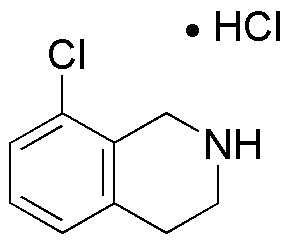8-Chloro-1,2,3,4-tetrahydroisoquinoline hydrochloride is widely utilized in research focused on:
- Pharmaceutical Development: This compound serves as a key intermediate in the synthesis of various pharmaceuticals, particularly those targeting neurological disorders, enhancing drug efficacy and specificity.
- Neuroscience Research: It is used in studies investigating neurotransmitter systems, offering insights into brain function and potential treatments for mental health conditions.
- Organic Synthesis: The compound acts as a versatile building block in organic chemistry, facilitating the creation of complex molecules with applications in medicinal chemistry.
- Analytical Chemistry: It is employed in the development of analytical methods for detecting and quantifying related compounds, improving quality control in pharmaceutical manufacturing.
- Biological Activity Studies: Researchers utilize this compound to explore its biological properties, contributing to the understanding of its potential therapeutic effects and safety profiles.
General Information
Properties
Safety and Regulations
Applications
8-Chloro-1,2,3,4-tetrahydroisoquinoline hydrochloride is widely utilized in research focused on:
- Pharmaceutical Development: This compound serves as a key intermediate in the synthesis of various pharmaceuticals, particularly those targeting neurological disorders, enhancing drug efficacy and specificity.
- Neuroscience Research: It is used in studies investigating neurotransmitter systems, offering insights into brain function and potential treatments for mental health conditions.
- Organic Synthesis: The compound acts as a versatile building block in organic chemistry, facilitating the creation of complex molecules with applications in medicinal chemistry.
- Analytical Chemistry: It is employed in the development of analytical methods for detecting and quantifying related compounds, improving quality control in pharmaceutical manufacturing.
- Biological Activity Studies: Researchers utilize this compound to explore its biological properties, contributing to the understanding of its potential therapeutic effects and safety profiles.
Documents
Safety Data Sheets (SDS)
The SDS provides comprehensive safety information on handling, storage, and disposal of the product.
Product Specification (PS)
The PS provides a comprehensive breakdown of the product’s properties, including chemical composition, physical state, purity, and storage requirements. It also details acceptable quality ranges and the product's intended applications.
Certificates of Analysis (COA)
Search for Certificates of Analysis (COA) by entering the products Lot Number. Lot and Batch Numbers can be found on a product’s label following the words ‘Lot’ or ‘Batch’.
*Catalog Number
*Lot Number
Certificates Of Origin (COO)
This COO confirms the country where the product was manufactured, and also details the materials and components used in it and whether it is derived from natural, synthetic, or other specific sources. This certificate may be required for customs, trade, and regulatory compliance.
*Catalog Number
*Lot Number
Safety Data Sheets (SDS)
The SDS provides comprehensive safety information on handling, storage, and disposal of the product.
DownloadProduct Specification (PS)
The PS provides a comprehensive breakdown of the product’s properties, including chemical composition, physical state, purity, and storage requirements. It also details acceptable quality ranges and the product's intended applications.
DownloadCertificates of Analysis (COA)
Search for Certificates of Analysis (COA) by entering the products Lot Number. Lot and Batch Numbers can be found on a product’s label following the words ‘Lot’ or ‘Batch’.
*Catalog Number
*Lot Number
Certificates Of Origin (COO)
This COO confirms the country where the product was manufactured, and also details the materials and components used in it and whether it is derived from natural, synthetic, or other specific sources. This certificate may be required for customs, trade, and regulatory compliance.


